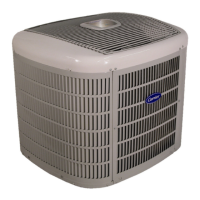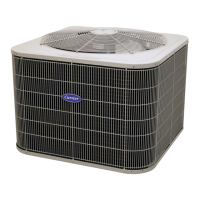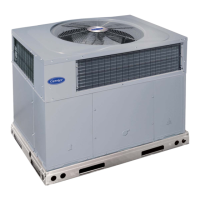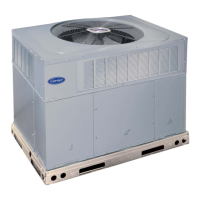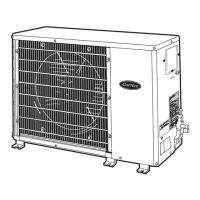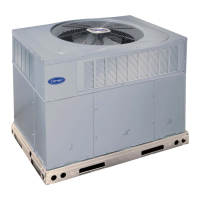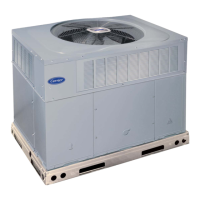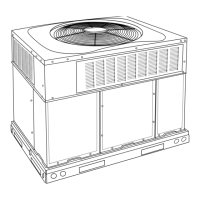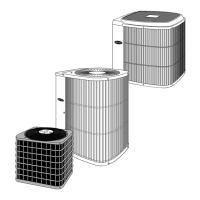25TPB7: Installation Instructions
Manufacturer reserves the right to change, at any time, specifications and designs without notice and without obligations.
10
Check Charge
NOTE: CHARGE IN HIGH STAGE ONLY.
Factory charge amount and desired subcooling are shown on unit rating
plate. Charging method is shown on information plate inside unit. To
properly check or adjust charge, conditions must be favorable for
subcooling charging. Favorable conditions exist when the outdoor
temperature is between 70°F and 100°F (21.1°C and 37.8°C), and the
indoor temperature is between 70°F and 80°F (21.1°C and 26.7°C).
Follow the procedure below:
Unit is factory charged for 15ft (4.6 m) of lineset. Adjust charge by
adding or removing 0.6 oz/ft (.018 kg/m) of 3/8 liquid line above or
below 15ft (4.6 m) respectively.
For standard refrigerant line lengths (80 ft/24.4 m or less), allow system
to operate in cooling mode at least 15 minutes. If conditions are
favorable, check system charge by subcooling method. If any adjustment
is necessary, adjust charge slowly and allow system to operate for 15
minutes to stabilize before declaring a properly charged system.
If the indoor temperature is above 80°F (26.7°C), and the outdoor
temperature is in the favorable range, adjust system charge by weight
based on line length and allow the indoor temperature to drop to 80°F
(26.7°C) before attempting to check system charge by subcooling
method as described above.
If the indoor temperature is below 70°F (21.1°C), or the outdoor
temperature is not in the favorable range, adjust charge for line set length
above or below 15ft (4.6 m) only. Charge level should then be
appropriate for the system to achieve rated capacity. The charge level
could then be checked at another time when the both indoor and outdoor
temperatures are in a more favorable range.
NOTE: If line length is beyond 80 ft (24.4 m) or greater than 20 ft (6.1
m) vertical separation, See Long Line Guideline for special charging
requirements.
Heating Check Chart Procedure
To check system operation during heating cycle, refer to the Heating
Check Chart on outdoor unit. This chart indicates whether a correct
relationship exists between system operating pressure and air
temperature entering indoor and outdoor units. If pressure and
temperature do not match on chart, system refrigerant charge may not be
correct. Do not use chart to adjust refrigerant charge.
Verify units for proper switching between low & high
stages
Check the suction pressures at the service valves. Suction pressure
should be reduced by 3-10% when switching from low to high capacity.
Compressor current should increase 20-45% when switching from low
to high stage. The compressor solenoid when energized in high stage,
should measure 24vac at leads inside control box.
When the compressor is operating in low stage the 24v DC compressor
solenoid coil is de-energized. When the compressor is operating in high
stage, the 24v DC solenoid coil is energized. The solenoid plug harness
that is connected to the compressor HAS an internal rectifier that
converts the 24v AC signal to 24v DC. DO NOT INSTALL A PLUG
WITHOUT AN INTERNAL RECTIFIER.
Unloader Test Procedure
The unloader is the compressor internal mechanism, controlled by the
DC solenoid, that modulates between high and low stage. If it is
suspected that the unloader is not working, the following methods may
be used to verify operation.
1. Operate the system and measure compressor amperage. Cycle the
unloader on and off at 30 second plus intervals at the thermostat
(from low to high stage and back to low stage). Wait 5 seconds
after staging to high before taking a reading. The compressor
amperage should go up or down at least 20 percent.
2. If the expected result is not achieved, remove the solenoid plug
from the compressor and with the unit running and the thermostat
calling for high stage, test the voltage output at the plug with a DC
voltmeter. The reading should be 24 volts DC.
3. If the correct DC voltage is at the control circuit molded plug,
measure the compressor unloader coil resistance. The resistance
should be approximately 1640 milliohms. If the coil resistance is
infinite or is grounded, the compressor must be replaced.
Final Checks
IMPORTANT: Before leaving job, be sure to do the following:
1. Ensure that all wiring is routed away from tubing and sheet metal
edges to prevent rub-through or wire pinching.
2. Ensure that all wiring and tubing is secure in unit before adding
panels and covers. Securely fasten all panels and covers.
3. Tighten service valve stem caps to 1/12-turn past finger tight.
4. Leave Owner’s Manual with owner. Explain system operation and
periodic maintenance requirements outlined in manual.
5. Fill out Dealer Installation Checklist and place in customer file.

